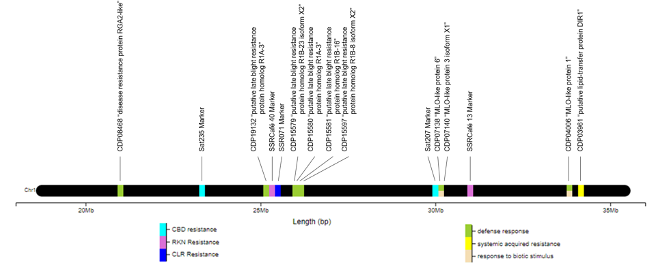VOLUME 14 NUMBER 2 (July to December 2021)

SciEnggJ. 2021 14 (2) 226-234
available online: October 18, 2021
*Corresponding author
Email Address: nssantos1@up.edu.ph
Date received: August 12, 2021
Date revised: September 26, 2021
Date accepted: October 5, 2021
ARTICLE
Bioinformatics survey for candidate resistance genes in the Coffea canephora Ck-1 gene region
Patricia Louise A. Yu, Nick Rainier S. Santos*, Daisy May C. Santos, and Ernelea P. Cao
Institute of Biology, College of Science, University of the Philippines,
Diliman, Quezon City, 1101
Diliman, Quezon City, 1101
Coffea sp. is a major crop, both internationally and locally in the Philippines. The Philippines is a major coffee consumer but a minor producer. Once a leading producer in the past, Philippines’ coffee plantations dwindled due to disease outbreaks. In order to help prevent infestations of that scale again, the genetic aspect of resistance needs to be elucidated further. Using the genetic markers Sat207 and Sat235, previous studies have putatively identified a Ck-1 gene linked to resistance against Coffee Berry Disease (CBD) caused by the fungus Colletotrichum kahawae. While a more recent study has determined that Sat207 and Sat235 are located in Chromosome 1, Ck-1 and its protein product remain uncharacterized. In this study, bioinformatics tools and coffee genomes available at GenBank were used to provide a preliminary list of candidates which may correspond to Ck-1. The C. canephora genome (GCA_900059795.1) was used as the primary reference. The probable locations of Sat207 and Sat235 in the genome were determined and it was found that the region potentially contains other genetic markers linked to resistance against other diseases and pests. To come up with the candidate genes, the first method involved obtaining genes within the hypothetical Ck-1 region from PlantEnsembl. The Orange Data Mining tool was used to filter them based on their gene ontology annotations: “defense response”, “systemic acquired resistance” and “response to biotic stimuli”. Ten potential resistance genes were identified. The second method involved using the online Plant Secondary Metabolite Analysis (PlantiSmash) tool to look for biosynthetic gene clusters (BGC), two of which were identified near the same region. One of these two BGCs could be involved in resistance. These candidate resistance genes could be used in marker-assisted selection of disease resistant coffee varieties.
© 2024 SciEnggJ
Philippine-American Academy of Science and Engineering